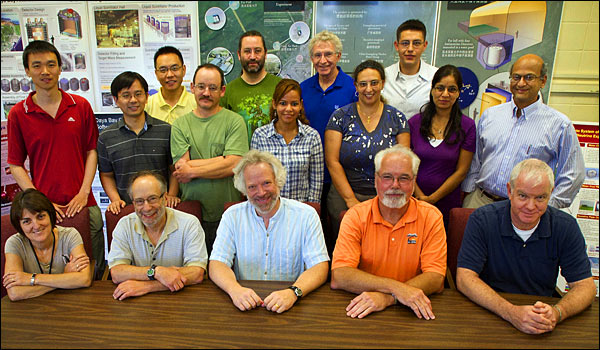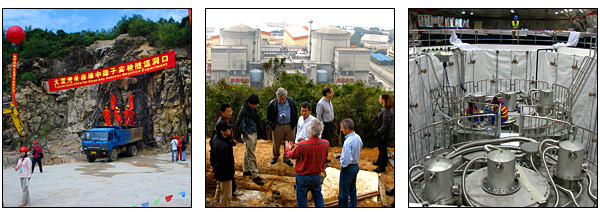Daya Bay Today: BNL and Collaborators Enable Next Step in Neutrino Research
November 2, 2011
The Daya Bay Neutrino Project, which uses the Guangdong Nuclear Power Group’s reactors in southern China as a source of antineutrinos, is primed to measure the last piece of the neutrino puzzle. It began taking data from the first of three planned experimental halls earlier this year, and the second hall should be up and running within the next few weeks. The collaboration is international and includes strong teams from China and the US as well as teams from other countries and regions including Taiwan, Hong Kong, Russia and the Czech Republic. Brookhaven National Laboratory has made significant contributions to this experiment, the latest step in the saga of neutrino research.

Members of the BNL team on the Daya Bay Neutrino Project include: (seated, from left) Penka Novakova, Laurie Littenberg, Steve Kettell, Ralph Brown, and Bob Hackenburg; (standing, from left) Zhe Wang, Chao Zhang, Jiajie Ling, David Jaffe, Brett Viren, Wanda Beriguete, Ron Gill, Mary Bishai, Richard Rosero, Sunej Hans, and Milind Diwan. Missing from the picture are: Donna Barci, Wai-Ting Chan, Chellis Chasman, Debbie Kerr, Hide Tanaka, Minfang Yeh, and Elizabeth Worcester.
“Brookhaven’s chemistry and physics departments have major leadership roles in the experiment, from designing the detectors all the way through to analysis of the data gathered,” says Steve Kettell, chief scientist for the U.S. Daya Bay Project and leader of Brookhaven's Electronic Detector Group.
Ghostly Neutrinos
Neutrinos are the ghosts of the particle physics world. Most of them pass through anything and everything, even entire planets, without interacting. At a given moment, tens of billions of neutrinos are passing through every square centimeter of the Earth’s surface — including you and me — without our noticing it. This makes detecting them especially problematic. What’s more, they come in three flavors: electron, muon, and tau — and each has its own quirks that necessitate specific detection techniques. Neutrinos are also able to change between these three forms, a process characterized by numbers known as “mixing angles.”
Previous experiments have measured the way neutrinos oscillate between the tau and muon forms and the muon and electron forms. However, the mixing angle that characterizes oscillations between the electron and tau forms, known as θ13 (“theta-one-three”), is the one parameter describing neutrinos that remains a mystery.
Antineutrinos
The reactors being used for the Daya Bay experiment produce many more antineutrinos than neutrinos, says Kettell. “In theory, measuring the way antineutrinos oscillate between electron and tau forms should tell us the currently unobserved mixing angle θ13,” he said. “Because neutrinos and antineutrinos are antipartners of one another, the way their forms oscillate should be equivalent.” So, all other things being equal, it made sense to use antineutrinos to investigate this unknown parameter: more particles mean more data and a better measurement.
At the moment, Daya Bay’s first twin detectors are recording the interactions of antineutrinos as they travel away from the reactors. This is only the first set of planned detector pairs. There will eventually be four nearly identical detector pairs set up in three different experimental halls. These will be built deep under adjacent mountains to shield them from any interfering particles from space.
BNL’s Team at Daya Bay
As the project prepares for the next step, Brookhaven maintains a major presence. For any collaboration of this scale, the number of people needed is dizzying.
Kettell, as chief scientist for the U.S. effort, is a member of the collaboration executive board and oversees many aspects of the project, including detector design and commissioning.
Brookhaven’s Ralph Brown of the Physics Department is the chief engineer for the U.S. effort at Daya Bay, and he manages the technical direction of the project — from assembly and installation through the interfaces between the various mechanical systems that make up the equipment, a vital job on such a technologically intensive project.
Brown offers the following anecdote describing one of the hurdles of his job: “I had to find a heavy haul vehicle capable of transporting an assembled [25-ton] antineutrino detector underground to the liquid scintillator filling hall, and then, once it was filled [now weighing 110 tons] to the experimental halls for installation.”
Meanwhile, Hide Tanaka is commissioning co-coordinator and is responsible for the set up and debugging of the detectors. He has spent significant time in China making sure all of the detectors work as designed.
Within those detectors, of course, are various vital subsystems. Richard Hahn and Minfang Yeh of Brookhaven’s Chemistry Department devised the “recipe” for the clear liquid scintillator that fills the massive cylindrical detectors. This liquid reveals antineutrino interactions by very faint flashes of light. They have also approved materials that come into contact with the liquid scintillator to ensure it won’t interfere with the scintillator’s ability to detect antineutrinos.
Similarly, Laurie Littenberg and Bob Hackenburg of physics handle management of the muon-veto system, which protects the antineutrino detectors from ambient radioactivity present in the rock. The system also identifies false signals caused by interactions of cosmic rays that manage to penetrate the caverns containing the detectors.
On a project of this scale — deep underground and with heavy equipment — safety is a major concern, and the project’s safety officer is Ron Gill of BNL’s Physics Department (who has taken over from Dana Beavis, also of physics). Gill is responsible for the safety of all equipment, facilities, and practices.
Finally, once the experiment is up and running, everything’s safe, and data are being collected, David Jaffe and his analysis coordination committee are in charge of data analysis. They helped to develop techniques for simulation and provided input on the development of software that enables the analysis process.
Naturally, “all of these positions are supported by many others here at BNL,” notes Kettell.
Past Present in Future
Hahn, a longtime (now retired) neutrino researcher at BNL, who was a major proponent of BNL’s involvement in Daya Bay, points out that the Daya Bay experiment is a natural extension of BNL’s history (see sidebar): “We’ve been in the neutrino business for years,” he says, “and we’ve participated in several important experiments in the field.”

Left: Groundbreaking Ceremony for the Daya Bay experiment in October 2007
Center: Daya Bay collaborators on hill above near hall, with reactors in background
Right: Antineutrino detectors being installed
Says Associate Lab Director of Nuclear & Particle Physics Steve Vigdor, a member of Daya Bay’s laboratory oversight group, “Although this important collaboration between the U.S. and China has had to overcome challenges arising from cultural differences, it is now poised to provide both forefront science and a template for future scientific collaborations between our two countries.”
By making Daya Bay possible, Brookhaven is helping to open the door to the next step in neutrino research. Understanding neutrinos, says Kettell, could be the gateway to answers to some of the most profound questions plaguing physicists today: Why do we live in a universe where matter vastly outweighs antimatter? Why do we exist at all?
2011-2641 | INT/EXT | Newsroom









